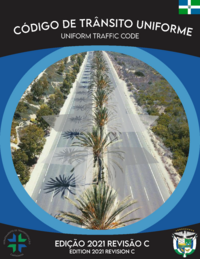Road signs in Cartadania: Difference between revisions
mNo edit summary |
|||
| Line 25: | Line 25: | ||
[[Category: Cartadania]] | [[Category: Cartadania]] | ||
[[Category: Infrastructure in Cartadania]] | [[Category: Infrastructure in Cartadania]] | ||
{{Template:Award winning article}} | |||
[[Category:2023 Award winning pages]] | |||
[[Category:IXWB]] | |||
Latest revision as of 12:24, 27 November 2023
This article is a work-in-progress because it is incomplete and pending further input from an author. Note: The contents of this article are not considered canonical and may be inaccurate. Please comment on this article's talk page to share your input, comments and questions. |
Road signs in Cartadania represent a vital component of the nation's transportation infrastructure and safety protocols. These signs, standardized and predominantly regulated by the federal government through the Department of Transportation under the banner of the Uniform Traffic Code, serve as indispensable guides for motorists, pedestrians, and cyclists navigating the extensive network of roadways that crisscross the country. While the federal government lays down overarching guidelines for signage, there exists a nuanced interplay with state and territorial authorities. These subnational entities, steeped in distinct histories and legislative traditions, occasionally uphold signage codes predating or supplementing the federal directives. However, the overarching theme is one of homogeneity.
History

The history of road signs in Cartadania traces its origins to the early days of the 20th century when the government recognized the need for standardized signage to facilitate communication on the burgeoning road network. Drawing inspiration from the practices of their former colonial ruler, Caphiria, as well as other nations, Cartadanian officials embarked on a journey to establish a coherent and effective system of road signs, one that would eventually become standardized across the union.
In the early years, road signs were rudimentary, often consisting of hand-painted wooden boards with simple symbols and text. Their primary purpose was to provide basic directions and warnings to travelers. These early signs were erected by local authorities, leading to significant variability in design and placement. As Cartadania expanded both territorially and economically, the need for a more unified approach to road signage became apparent. In 1907, the federal government took a decisive step by passing the Signage Standardization Act, which aimed to harmonize the various state and regional signage practices. This landmark legislation established a framework for the development, installation, and maintenance of road signs across the country. It introduced standardized shapes, colors, and symbols, creating a system that was not only consistent but also easily comprehensible to a diverse population.
The subsequent decades saw continuous refinements to the signage system, guided by a commitment to road safety and efficiency. Innovations such as reflective paint and materials, introduced in the early 20th century, greatly improved visibility at night and during adverse weather conditions. The early mid-20th century witnessed the birth of the first comprehensive Uniform Traffic Code (UTC), serving as a comprehensive guide for both federal and state authorities.
During the mid-20th century, as Cartadania's road network continued to expand and diversify, the need for more detailed and specialized signage became evident. This led to periodic revisions of the UTC, accommodating advancements in technology and transportation practices. Notably, the federal government worked in close collaboration with state and local agencies, ensuring that the signage system remained adaptive to regional needs and preferences.
Today, Cartadania boasts a highly effective and standardized road signage system that aligns with continental best practices. Road signs serve as essential navigational aids, conveying critical information to motorists, pedestrians, and cyclists alike. While rooted in historical developments, the road signage system continues to evolve and the UTC continues to be updated as needed.
Table of traffic signs comparison
Priority/Regulatory
Warning
Schools
Guide
Special regulations
Indication
See also